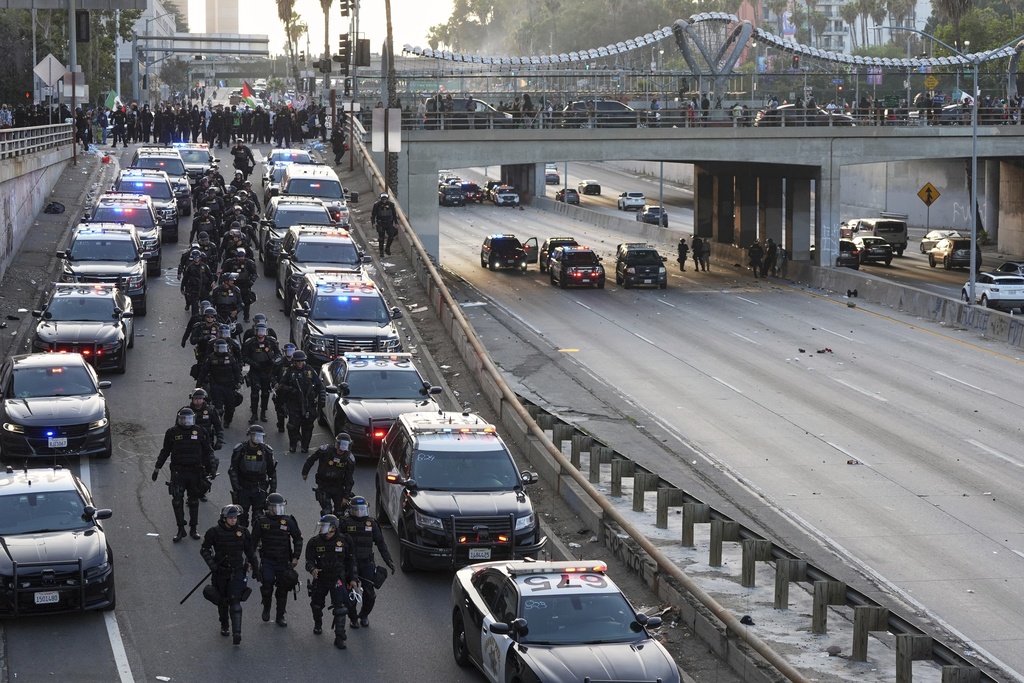On Sunday, President Donald Trump activated the California National Guard without the consent of the state’s governor and deployed 700 Marines to the area.
Protests over the moves have broken out across the nation, including in Milwaukee. Wisconsin Gov. Tony Evers signed a letter speaking out against the deployment, calling it an alarming abuse of power and stressing the importance of a state’s ability to manage its National Guard.
And California Gov. Gavin Newsom sent a warning to state governors on NPR’s “All Things Considered.”
Stay connected to Wisconsin news — your way
Get trustworthy reporting and unique local stories from WPR delivered directly to your inbox.
“Regardless of your political stripe, this is a preview of things to come,” he said.
John Hall is a military historian at the University of Wisconsin-Madison and a retired U.S. Army Reserve colonel. He told WPR’s “Wisconsin Today” the deployment of the state National Guard could “absolutely” happen here.
“[The president] has made clear that his definition of what constitutes unlawful combinations, in terms of protests, is relatively low,” Hall said. “So where protests emerge, he has threatened he will take similar measures to respond to those protests.”
“Moreover, he seems to be suggesting that states and municipalities that, in his judgment, are interfering with ICE’s mass deportation efforts right now are themselves obstructing the laws of the United States,” Hall continued.
As protests are expected around the country Saturday, including in Wisconsin cities, Hall talked with “Wisconsin Today” about the historic role of the National Guard and why the type of deployment seen in Los Angeles is so rare.
This conversation has been edited for brevity and clarity.
Rob Ferrett: Are there standards for when a president can deploy the National Guard despite objections from the governor? What are the steps that are usually taken in a situation like this?
John Hall: It’s helpful to keep in mind the original context in which Congress decided to make this delegation of authority to the president. It was an era in which Congress would go into recess and be days or weeks away from the national capital.

The idea was the president cannot sit on his hands if a foreign force invades the United States, waiting for Congress to come back to New York or Philadelphia and eventually Washington to authorize him to do this. So it really was almost a response to technological incapacity of that era.
But generally speaking, the one that the president has teased he is considering invoking is the so-called Insurrection Act. It generally speaks to the same sort of conditions of invasions or rebellions, unlawful combinations, things that prevent the execution of the laws of the state or the federal government.
RF: It seems like in American history, we’ve been more reluctant to use active duty military for law enforcement and security purposes.
JH: Absolutely and with very good reason. So the nation was founded with a congenital fear of what they then called standing armies. That is the idea that regular army soldiers kept under arms and in uniform and under military discipline in times of peace, historically, had shown themselves to be the tools of tyrants, and so the founding generation did not want such an army.
A lot of the debate that’s going on right now about the current deployment sort of hints around the concerns of this historically, but the one thing that it misses is that the regular forces of the United States have wanted to stay far clear of these kinds of deployments throughout history.
Past cases in which they have been deployed in this manner have really put them in the crosshairs of acrimonious political debates where they do not like to be. Particularly post-Vietnam, it took the military a generation to rebuild public trust and they are very, very wary of squandering that public trust by being thrust into circumstances like this.
RF: The National Guard might help with voting during the pandemic or for civil disturbances. They might deploy overseas. They have some training relevant to this. But active duty troops like the Marines, do they have training when it comes to handling protests?
Not generally. It would be specialized training in preparation for a particular contingency or mission.
The National Guard is sort of a Swiss Army knife. It’s another one of the reasons why it is the force of first resort when the local capacity of law enforcement has been exceeded, and you need to enhance that capacity, or you need additional capabilities.
The National Guard is very well integrated with other state agencies. And the troops of the National Guard, depending upon their specific specialty, may be trained in how to respond to riots as a matter of course.
Not to say that they are beyond criticism. Two of the most regrettable events in the history of the National Guard were in 1970 with deadly shootings at Kent State and Jackson State.
But that notwithstanding, the National Guard is generally more competent in the measured use of force to respond to these kinds of emergencies.
Whereas within the Army or Marine Corps forces, that’s not generally what they train to do on a day-to-day basis if they get orders.





